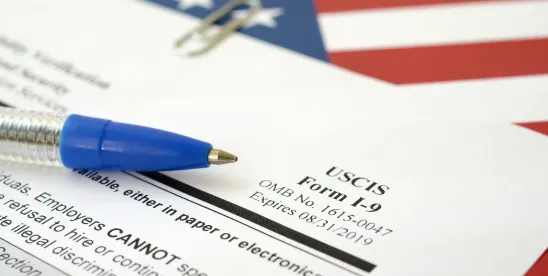The U.S. Department of Homeland Security (DHS) has begun revoking employment authorization documents (EADs) for certain noncitizens whose parole into the United States has been terminated. This includes individuals paroled through the Cuba, Haiti, Nicaragua, and Venezuela (CHNV) program, as well as on a case-by-case basis for those admitted through other immigration processes. In response, E-Verify has launched a new “Status Change Report” to help employers identify affected employees and comply with Form I-9 reverification requirements.
Quick Hits
- DHS has started revoking employment authorization documents (EADs) for certain noncitizens, including those paroled under the CHNV program, and E-Verify has introduced a new “Status Change Report” to help employers comply with Form I-9 reverification requirements.
- Employers are now required to regularly generate and review the new E-Verify “Status Change Report” to identify employees with revoked EADs and reverify their work authorization using Form I-9, Supplement B.
- The shift from E-Verify Case Alerts to the employer-initiated Status Change Report increases administrative responsibilities for employers, necessitating regular monitoring and secure handling of sensitive personal data.
Background
Under U.S. immigration law, individuals paroled into the United States may receive temporary work authorization, typically documented through an EAD. DHS retains discretionary authority to terminate parole at any time, which also results in the revocation of the parole-based EAD. Recently, DHS began exercising this authority more broadly, including for specific groups such as those paroled under the CHNV program. Those impacted by the revocations will receive direct revocation notices from DHS. Although these EADs may still appear valid to employers, they are no longer acceptable for work authorization.
Previously, E-Verify issued “Case Alerts” to notify employers when an employee’s EAD was revoked. DHS has now created a centralized reporting method to assist employers in identifying impacted employees. The new “Status Change Report” streamlines the process and ensures more consistent access to updated revocation data.
Employers are now expected to take a more active role in monitoring EAD revocation information and respond accordingly.
Process Changes
New E-Verify Tool
The Status Change Report replaces previous Case Alerts and helps employers identify E-Verify cases tied to revoked EADs. The report is updated regularly and includes document revocation dates, case numbers, and A-Numbers.
Employer Obligations
- Log in to E-Verify and generate the Status Change Report regularly.
- Use Form I-9, Supplement B to reverify work authorization for affected employees.
- Do not create a new E-Verify case for these employees.
- Employers and employer agents must protect personally identifiable information when sharing reports.
Accessing the Report
- Employers and employer agents can generate the report from the “Reports” tab in E-Verify.
- The report can be filtered by specific revocation dates or downloaded in CSV format.
- Employer agents must ensure secure sharing of report data with client companies.
Analysis and Impact
The introduction of the Status Change Report shifts the burden of monitoring EAD revocations from E-Verify notifications to employer-initiated reporting. This change increases administrative oversight and requires employers to implement regular processes for reviewing updated case data.
Compliance: Employers may want to closely monitor their E-Verify reports and complete reverification promptly using Form I-9, Supplement B, to avoid unauthorized employment. Failing to identify and reverify affected employees promptly could result in continuing to employ people without authorization and related civil penalties.
Employee status: Employees may remain eligible to work under another status but must provide new documentation from List A or List C showing ongoing authorization to work in the United States.
Process changes: The elimination of EAD revocation Case Alerts requires employers to actively generate and review the new Status Change Report on a regular basis. Employer agents must ensure secure transmission of the Status Change Report due to the inclusion of sensitive personal data.






 />i
/>i
